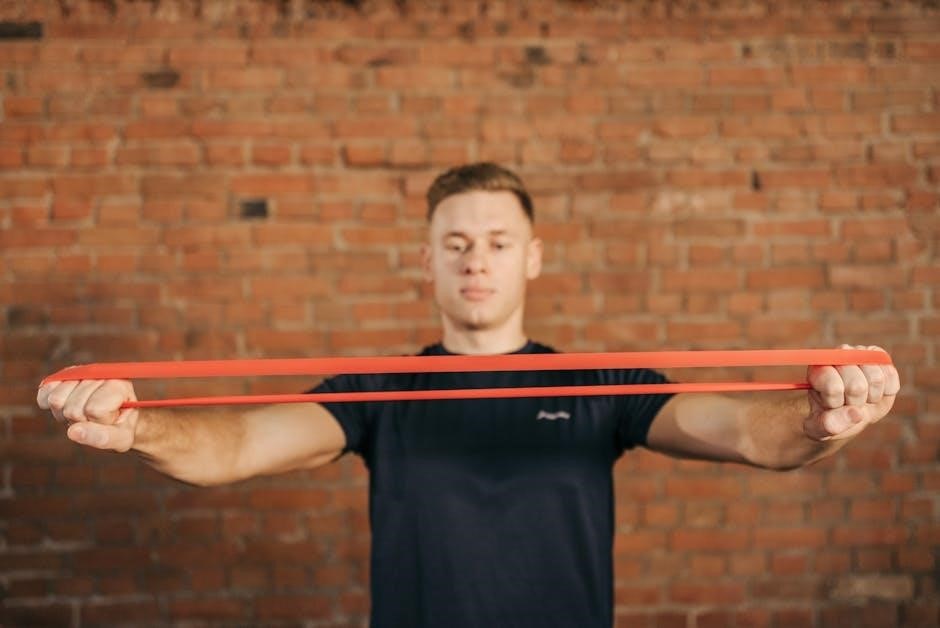Manual stretching is a therapeutic technique where physical therapists use hands-on methods to elongate muscles and soft tissues, improving flexibility and range of motion. It is widely used in rehabilitation and injury recovery, offering both physical and mental benefits by reducing muscle tension and stress. This approach enhances mobility, promotes relaxation, and supports overall well-being, making it a cornerstone in modern therapeutic care.
Definition and Purpose of Manual Stretching
Manual stretching is a hands-on therapeutic technique where a practitioner uses targeted movements to elongate muscles, tendons, and soft tissues. Its primary purpose is to enhance flexibility, improve joint range of motion, and reduce muscle tension. By applying controlled force, it helps restore optimal muscle length, promoting better posture, movement efficiency, and overall physical function. This method is widely used in rehabilitation, sports training, and massage therapy to address muscle imbalances and support therapeutic goals.
Historical Background of Manual Stretching Techniques
Manual stretching techniques have ancient roots, with evidence of their use in traditional Chinese medicine and Greek therapies. Early practices focused on improving mobility and treating injuries. Over centuries, these methods evolved, incorporating insights from physical therapy and sports medicine. The 20th century saw the development of systematic approaches, including proprioceptive neuromuscular facilitation (PNF) and passive stretching. These advancements refined manual stretching into a scientific practice, widely adopted today in clinical and therapeutic settings to enhance flexibility and aid rehabilitation.
Importance of Manual Stretching in Modern Therapy
Manual stretching plays a vital role in modern therapy, enhancing flexibility, reducing muscle tension, and improving joint mobility. It is widely used in physical therapy, sports rehabilitation, and massage therapy to aid recovery and prevent injuries. By targeting specific muscle groups, manual stretching promotes relaxation, reduces pain, and restores functional movement. Its effectiveness in addressing musculoskeletal issues has made it a cornerstone in therapeutic practices, complementing other treatments like strength training and exercise programs to optimize patient outcomes and overall well-being.

Benefits of Manual Stretching
Manual stretching improves flexibility, reduces muscle tension, and enhances joint mobility, promoting overall physical well-being and complementing various therapeutic approaches for optimal health outcomes.
Physical Benefits: Improved Flexibility and Range of Motion
Manual stretching enhances flexibility by elongating muscles and connective tissues, allowing for greater joint mobility. Regular practice reduces stiffness, enabling smoother movement and improved physical performance. It also increases blood flow, promoting healthy tissue repair and maintenance. Over time, consistent stretching can prevent muscle imbalances, supporting better posture and reducing the risk of injuries. These physical improvements contribute to overall athletic and functional abilities, making manual stretching a valuable tool for both rehabilitation and daily wellness.
Mental and Emotional Benefits: Reduced Stress and Muscle Tension
Manual stretching promotes relaxation, reducing stress and muscle tension by releasing endorphins, which create a calming effect. The gentle, controlled movements help quiet the mind, alleviating anxiety and promoting emotional well-being. Regular stretching fosters a sense of calm, improving mood and reducing psychological strain. Over time, it enhances resilience to stress, leading to better emotional balance and a more relaxed mindset, contributing to overall mental health and quality of life.
Therapeutic Benefits: Rehabilitation and Injury Recovery
Manual stretching is a key tool in rehabilitation, aiding injury recovery by repairing damaged muscle fibers and restoring range of motion. It reduces stiffness, promotes blood flow, and accelerates healing. Gentle stretching techniques alleviate pain, improve joint mobility, and strengthen weakened tissues. Often used in physical therapy, manual stretching helps patients recover from injuries like tendon strains or post-surgery stiffness, supporting the body’s natural healing processes and enhancing overall recovery outcomes.
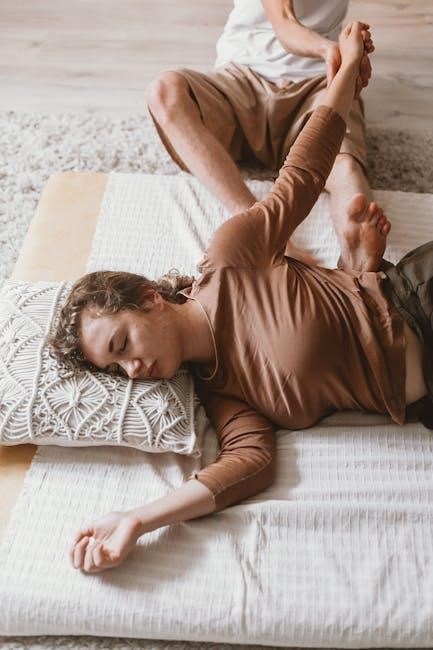
Manual Stretching Techniques
Manual stretching involves hands-on methods to elongate muscles and improve flexibility. Techniques include passive, active, and PNF stretching, enhancing range of motion and muscle balance effectively.
Passive Stretching: Techniques and Applications
Passive stretching involves an external force, such as a therapist or equipment, to stretch muscles without active participation. Techniques include static stretches held for 20-30 seconds, targeting specific muscle groups. Common applications include physical therapy for rehabilitation, improving joint mobility, and relieving muscle tightness. Passive stretching is particularly beneficial for individuals with limited movement or pain during active stretching. Proper form and breathing are emphasized to maximize effectiveness and prevent injury. This method complements other stretching techniques, enhancing overall flexibility and muscle relaxation.
Active Stretching: Methods and Effectiveness
Active stretching involves contracting and lengthening muscles dynamically, promoting flexibility and strength. Techniques include dynamic stretches like arm circles and leg swings, which prepare muscles for activity. Isotonic exercises, where muscles move through a range of motion, are also used. Active stretching enhances neuromuscular coordination and reduces muscle imbalances. It is particularly effective for athletes and individuals with active lifestyles, improving mobility and preventing injuries. Regular practice strengthens muscles while increasing joint range of motion, making it a valuable addition to fitness routines.
PNF Stretching: Proprioceptive Neuromuscular Facilitation
PNF stretching, or Proprioceptive Neuromuscular Facilitation, is an advanced technique that combines muscle contractions and stretching to improve flexibility and strength. It involves contracting specific muscle groups, then stretching them to enhance neuromuscular coordination. PNF is highly effective for rehabilitation, as it targets muscle imbalances and joint mobility. By stimulating proprioceptors, it improves muscle function and range of motion. This method is widely used in physical therapy to restore movement and strength, particularly after injuries or surgeries, making it a valuable tool for enhancing overall musculoskeletal health and function.
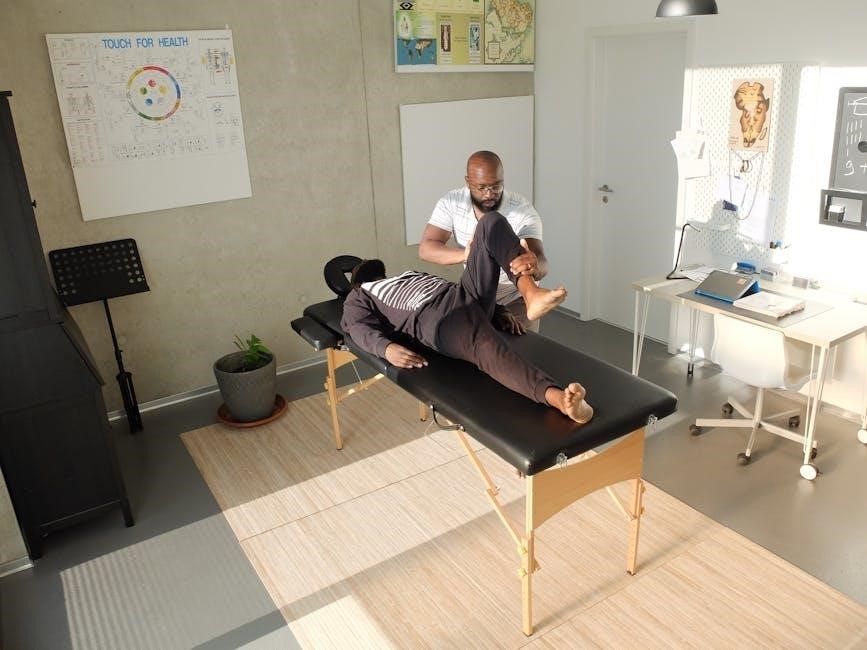
Preparation for Manual Stretching
Preparation involves warming up with light cardio, focusing on proper breathing techniques, and creating a safe, comfortable environment to ensure effective and injury-free stretching sessions.
Warm-Up Exercises: Essential for Safe Stretching
Warm-up exercises are crucial before manual stretching to prepare muscles and prevent injuries. Light cardio, such as jogging or cycling, and dynamic stretches like arm circles or leg swings, increase blood flow and flexibility. Proper form and controlled movements ensure safety. Warming up for 5-10 minutes readies the body for stretching, reducing the risk of muscle strain. This step is vital for maximizing the effectiveness of subsequent stretching techniques and maintaining overall muscle health.
Proper Breathing Techniques During Stretching
Proper breathing is essential during manual stretching to enhance relaxation and effectiveness. Deep, slow breaths help reduce muscle tension and promote flexibility. Inhale before stretching and exhale gradually while moving into the stretch. Avoid holding breath, as it increases tension and reduces oxygen flow. Consistent, rhythmic breathing synchronizes with movements, ensuring safe and productive stretching sessions. This practice minimizes discomfort and maximizes the benefits of manual stretching techniques, contributing to a more therapeutic experience.
Creating a Safe Environment for Stretching Sessions
Creating a safe environment for manual stretching involves ensuring a clean, open space with adequate lighting. Use mats or padded surfaces to prevent injuries and provide support. Secure any loose furniture or equipment to avoid accidents. Maintain a comfortable temperature to relax muscles and promote blood flow. Clear communication between therapist and client is crucial to understand limits and discomfort. Proper hygiene practices should be followed to maintain a sanitary setting, ensuring a safe and effective stretching experience for all participants.

Safety Considerations in Manual Stretching
Manual stretching requires attention to contraindications, avoiding overstretching, and recognizing pain signals. Proper techniques prevent injuries, ensuring safe and effective sessions for all individuals involved.
Identifying Contraindications for Manual Stretching
Manual stretching is not suitable for all individuals. Contraindications include acute injuries, fractures, severe osteoporosis, or active inflammation. Conditions like recent surgeries, joint instability, or certain neurological disorders may also require caution. It’s essential to assess each individual’s health status and avoid stretching techniques that could exacerbate existing conditions. Proper identification of contraindications ensures safe and effective stretching practices, preventing potential harm or discomfort during sessions. Always consult a healthcare professional for personalized guidance.
Avoiding Overstretching and Preventing Injuries
To prevent injuries during manual stretching, it’s crucial to avoid overstretching. Movements should be slow and controlled, avoiding bouncing or forcing muscles beyond a comfortable range. Pain is a signal to stop, as it indicates potential tissue damage. Always warm up before stretching and avoid stretching cold muscles. Overstretching can lead to micro-tears, inflammation, or reduced muscle stability. Prioritize gentle, sustained stretches and focus on gradual progression to enhance flexibility safely without compromising joint or muscle integrity.
Understanding Pain Signals During Stretching
Pain during stretching signals that a muscle or tissue is being overstretched or strained. It’s essential to recognize and respect this feedback to avoid injury. A gentle stretch should feel discomfort-free, while pain indicates exceeding the muscle’s current capacity. If pain occurs, stop the stretch immediately and modify the technique or reduce intensity. Ignoring pain can lead to muscle damage or prolonged recovery. Listening to these signals ensures safe and effective stretching, promoting progress without harm.
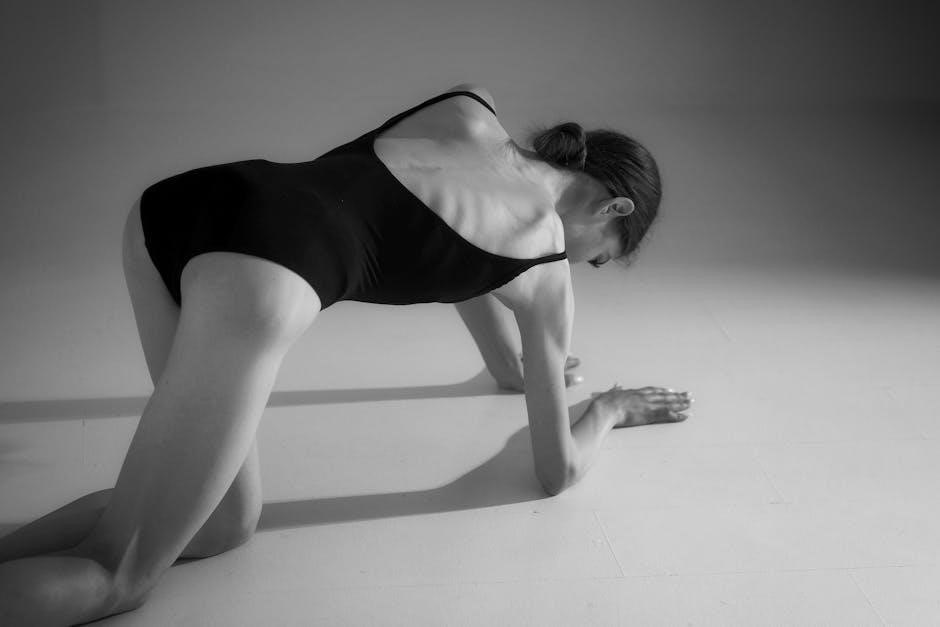
Applications of Manual Stretching
Manual stretching is widely used in physical therapy for rehabilitation, in massage therapy for muscle relaxation, and in sports training for injury prevention and enhanced performance.
Manual Stretching in Physical Therapy
Manual stretching in physical therapy is a hands-on technique used to improve flexibility, reduce muscle tension, and restore range of motion. Physical therapists apply controlled stretches to target specific muscle groups, aiding in rehabilitation after injuries or surgeries. This method enhances blood flow, reduces stiffness, and promotes healing. It is particularly effective for patients with musculoskeletal injuries, helping them regain strength and mobility. Regular sessions can accelerate recovery and improve overall physical function, making it a cornerstone in therapeutic care.
Manual Stretching in Massage Therapy
Manual stretching in massage therapy combines therapeutic touch with targeted stretching to enhance muscle relaxation and flexibility. Techniques often include gentle elongation of muscles, tendons, and ligaments, complementing traditional massage strokes. This approach helps reduce muscle spasms, improve circulation, and relieve chronic tension. It is particularly beneficial for clients with tight muscles, scar tissue, or restricted mobility. By integrating stretching with massage, therapists can address both physical and emotional stress, promoting a deeper state of relaxation and overall well-being.
Manual Stretching in Sports Training and Rehabilitation
Manual stretching is a vital component in sports training and rehabilitation, aiding athletes in improving flexibility, range of motion, and recovery. It targets specific muscle groups to enhance performance and prevent injuries. In rehabilitation, it helps restore mobility after injuries, particularly in areas like the rotator cuff and hamstrings. Passive and active stretching techniques are commonly used, allowing therapists to tailor sessions to individual needs. This hands-on approach ensures precise alignment and maximum benefit, making it an essential tool for optimizing athletic performance and expediting recovery.
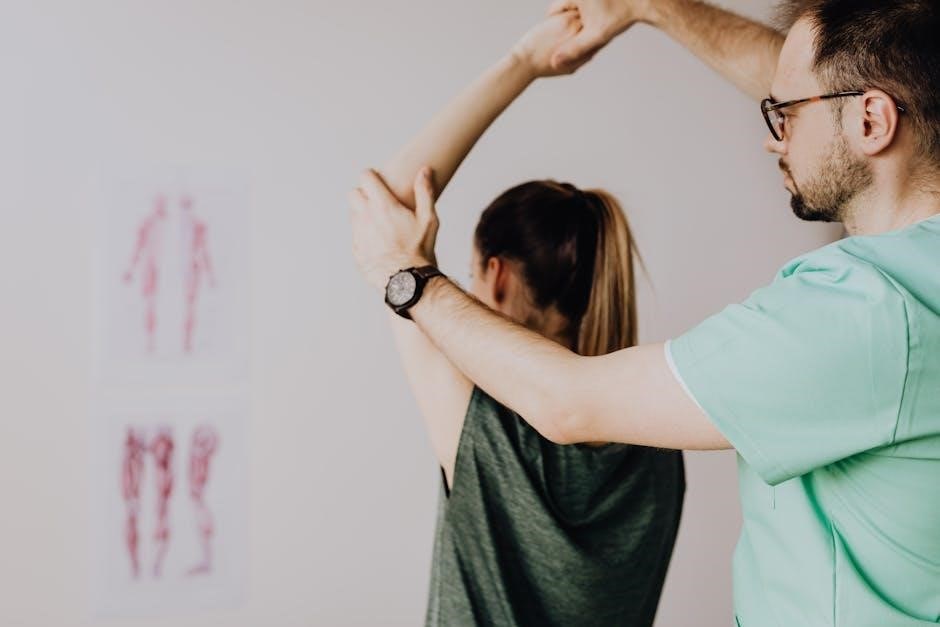
Manual Stretching Tools and Accessories
Manual stretching tools include straps, foam rollers, and massage balls. These accessories enhance flexibility, provide support, and aid in self-myofascial release for muscle relaxation. Portable and versatile, they are essential for both home and clinical use.
Using Stretching Straps for Enhanced Flexibility
Stretching straps are versatile tools designed to assist in manual stretching, offering enhanced flexibility by allowing deeper stretches with controlled resistance. They are particularly effective for targeting hard-to-reach muscle groups like hamstrings and hip flexors. By providing leverage, straps enable users to isolate specific areas, improving range of motion and reducing muscle tension. Their portability makes them ideal for both home use and clinical settings, complementing therapeutic techniques and self-stretching routines effectively. Regular use can lead to noticeable improvements in joint mobility and overall muscle elasticity.
Foam Rollers: Complementary Tools for Stretching
Foam rollers are widely used as complementary tools to enhance manual stretching techniques. They allow individuals to apply targeted pressure to specific muscle groups, promoting self-myofascial release and improving circulation. Regular use of foam rollers can reduce muscle tension, alleviate knots, and prepare muscles for deeper stretching. Their versatility makes them ideal for both home use and professional therapy settings, offering a cost-effective way to augment stretching routines and achieve better flexibility and muscle relaxation. They are particularly effective for large muscle areas like the quadriceps and hamstrings.
Massage Balls: Enhancing Manual Stretching Techniques
Massage balls are versatile tools that complement manual stretching by targeting specific muscle groups and improving muscle elasticity. They allow for precise pressure application, helping to release tension and knots in deeper tissues. Often used in combination with stretching exercises, massage balls enhance flexibility and range of motion. Their portability and ease of use make them ideal for both therapeutic settings and home practice, offering a effective way to prepare muscles for stretching and promote overall relaxation and muscle well-being.

Specific Manual Stretching Exercises
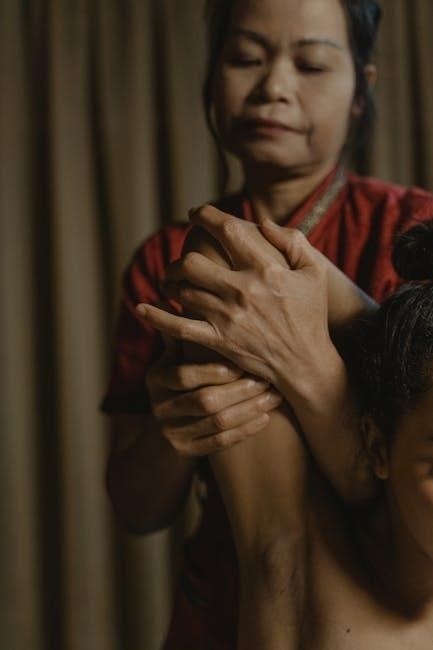
Targeted exercises focus on key muscle groups like hamstrings, hip flexors, quadriceps, chest muscles, shoulders, and neck. These stretches improve flexibility, range of motion, and relieve muscle tension.
Hamstring and Hip Flexor Stretches
Hamstring and hip flexor stretches target tight muscles in the posterior thighs and hips, improving flexibility and reducing stiffness. Passive stretching involves a partner or therapist applying gentle force. Standing stretches, such as crossing one leg over the other, are effective for hip flexors. Hold stretches for 20-30 seconds to maximize benefits. Regular practice enhances range of motion, eases lower back pain, and prevents injuries. Always warm up beforehand and maintain proper form to avoid discomfort or strain during the exercises.
Quadriceps and Chest Muscle Stretches
Quadriceps stretches target the front thigh muscles, improving flexibility and reducing tightness. Standing stretches involve pulling the foot toward the buttocks, holding for 20-30 seconds. Chest muscle stretches open the shoulders and chest, enhancing posture and range of motion. Manual techniques, such as assisted stretches, help deepen the stretch safely. These exercises are particularly beneficial for athletes and individuals with desk jobs. Regular practice prevents injuries, eases muscle tension, and promotes better movement patterns. Consistency is key for long-term flexibility and overall muscle balance.
Shoulder and Neck Stretching Techniques
Shoulder and neck stretches alleviate tension and improve posture. Techniques include lateral neck stretches, where the head is gently tilted sideways, and shoulder shrugs to relieve muscle tightness. Cross-body stretches involve pulling the arm across the chest to target shoulder muscles. Manual assistance enhances depth and comfort. These exercises reduce stress, prevent injury, and enhance mobility; Regular practice promotes long-term flexibility and comfort in the upper body, essential for daily activities and overall well-being. Proper form ensures effectiveness and safety during stretching sessions.

Best Practices for Manual Stretching
Best practices include warming up, maintaining proper form, and performing slow, controlled movements. Avoid bouncing and stretching through pain. Consistency yields optimal results and prevents injuries.
Frequency and Duration of Stretching Sessions
For optimal results, stretching sessions should occur 3-5 times weekly, with each session lasting 10-20 minutes. Begin with a 5-minute warm-up using light cardio or dynamic stretches. Hold each stretch for 20-30 seconds and repeat 2-3 times. Focus on major muscle groups like hamstrings, quadriceps, and shoulders. Consistency is key for improving flexibility and range of motion. Avoid stretching when muscles are cold, as this increases injury risk. Listen to your body and adjust intensity based on comfort and progress.
Progressive Overload in Stretching: Safe Implementation
Progressive overload in stretching involves gradually increasing the intensity of stretches to enhance flexibility. Start with gentle stretches and slowly deepen them as tolerance improves. Use techniques like prolonged holds, dynamic movements, or resistance. Incorporate tools like straps or foam rollers to safely increase depth. Ensure proper warm-up and breathing to prevent injury. Avoid bouncing or force, as this can cause harm. Monitor progress and adjust techniques based on individual comfort and goals to achieve sustainable improvements in range of motion.
Combining Manual Stretching with Strength Training
Combining manual stretching with strength training enhances muscle balance and overall performance. Stretching improves flexibility, reducing muscle tension and risk of injury, while strength training builds power and endurance. Perform stretches before and after workouts to prepare and recover muscles. Focus on dynamic stretches for warm-ups and static stretches for cool-downs. This integrated approach promotes optimal muscle function, preventing imbalances and supporting long-term athletic development. It ensures a holistic fitness routine that addresses both mobility and strength for better physical health and stability.
Manual stretching is a powerful tool for improving flexibility, reducing muscle tension, and aiding rehabilitation. Consistent practice, combined with proper techniques, enhances mobility and overall well-being, making it essential for long-term physical health.
Summarizing the Key Points of Manual Stretching
Manual stretching is a therapeutic technique that enhances flexibility, reduces muscle tension, and promotes relaxation. It improves range of motion, aids in injury rehabilitation, and supports physical and mental well-being. Regular practice, combined with proper techniques, is essential for achieving optimal results. Consistency, safe methods, and personalized approaches ensure effectiveness, making manual stretching a valuable tool in therapy, sports, and daily health routines.
Encouraging Consistency in Stretching Practice
Consistency is key to achieving lasting benefits from manual stretching. Regular sessions, even brief ones, help maintain flexibility and prevent muscle tightness. Creating a routine that fits into daily life ensures adherence. Setting realistic goals and tracking progress can motivate individuals to stay committed; Incorporating stretching into post-workout cooldowns or morning routines makes it a sustainable habit. Over time, consistent practice fosters improved mobility and overall well-being, reinforcing the importance of making manual stretching a regular part of one’s health regimen.
The Future of Manual Stretching in Therapeutic Care
Manual stretching is evolving with advances in exercise physiology and biomechanics, refining its techniques for better therapeutic outcomes. Integration with emerging technologies, such as wearable devices, may enhance customization and remote monitoring. Therapists are increasingly adopting evidence-based practices, ensuring standardized and effective methods. As research expands, manual stretching will likely become more personalized, addressing specific patient needs and optimizing recovery processes. This approach promises to solidify its role as a vital component in modern rehabilitation and preventive care, offering tailored solutions for diverse populations and conditions.
